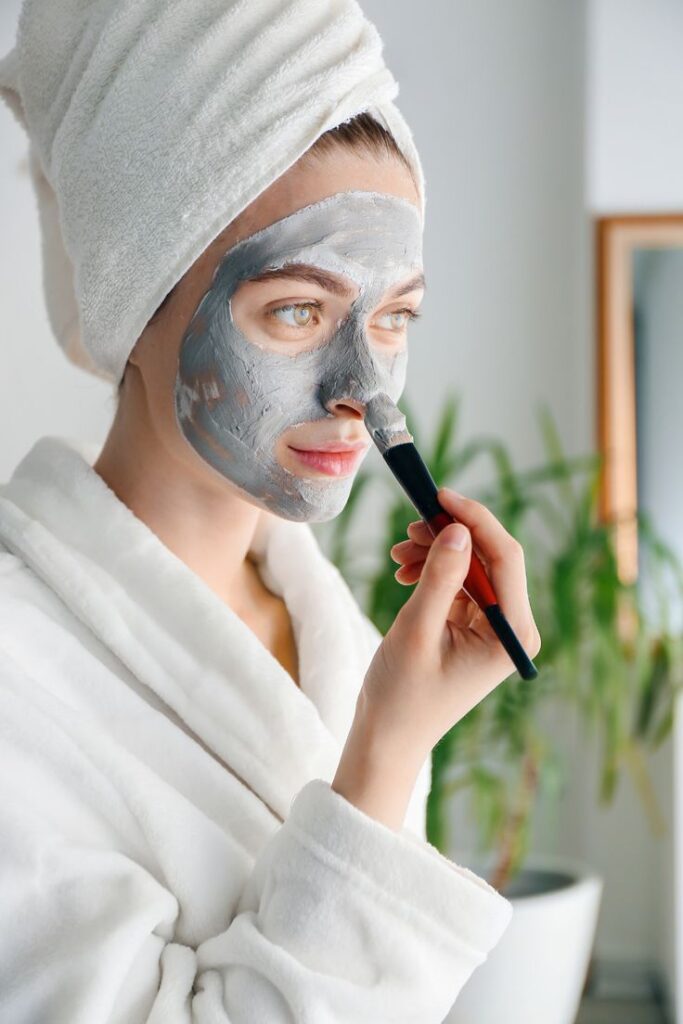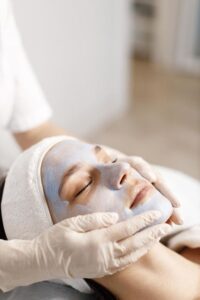If you’re battling a shiny complexion, frequent breakouts, and enlarged pores, you likely have oily skin. Managing oily skin can feel like a never-ending cycle of trial and error. However, with the right approach to your skin care routine, it’s possible to achieve a balanced, clear, and healthy-looking complexion. This guide will walk you through seven essential tips and tricks to tailor your skin care routine perfectly for oily skin.
Thank you for reading this post, don't forget to subscribe!From choosing the right products to the specific way you apply them, every step matters. Our goal is to help you harness your skin’s natural vitality without stripping it of essential nutrients or overburdening it with unnecessary products. So, let’s dive into the best practices that can transform your skin care regimen and help you manage your oily skin effectively Understanding Your Skin Type
Best Skin Care Routine for Oily Skin
Oily skin is primarily characterized by excess sebum production, which can lead to a glossy appearance and a greasy texture. This skin type often struggles with larger, more visible pores and a higher propensity for acne breakouts due to clogged pores. Common signs include a persistent shine, especially on the forehead, nose, and chin—areas famously known as the T-zone. Moreover, people with oily skin may find that makeup and other products do not stay on as long, slipping off or degrading throughout the day.
Recognizing and acknowledging these characteristics is crucial in tailoring an effective skin care routine. Understanding that not all oily skin behaves identically is essential; external factors like weather, stress, and hormonal changes can all influence sebum production. Additionally, your skin’s needs may vary based on your age, dietary habits, and other health factors.
Emphasizing the importance of personalization in skin care cannot be overstated. What works for one person might not work for another, even if both have oily skin. Hence, it’s essential to listen to your skin and observe how it reacts to different products and regimens. This personalized approach ensures that the skin care products and routines you choose are the most beneficial for your specific skin condition, ultimately leading to better skin health and appearance. By embracing a routine that addresses your unique needs, you set the stage for clearer, more balanced skin.
1. Choose the Right Skin Care Cleanser

The foundation of any effective skin care routine, particularly for oily skin, begins with the right cleanser. Using a gentle yet effective cleanser is crucial as it helps remove excess oil, dirt, and impurities without stripping the skin of its natural moisture. Harsh cleansers can trigger an increase in oil production as the skin tries to compensate for the loss of moisture, exacerbating oily skin issues.
For those with oily skin, look for cleansers that are specifically formulated to balance sebum levels without over-drying. Ingredients like salicylic acid are ideal as they help to break down the oil in clogged pores and promote exfoliation. Glycolic acid is another beneficial ingredient; it’s an alpha-hydroxy acid (AHA) that helps to gently exfoliate the skin, removing dead skin cells and promoting a clearer complexion.
Products that contain niacinamide can also be particularly effective, as this ingredient helps to reduce inflammation and control sebum production. For a physical ingredient that aids in oil control, look for cleansers with activated charcoal or clay, as they naturally absorb toxins and excess oils.
Some recommended products include:
- La Roche-Posay Effaclar Purifying Foaming Gel: This product is designed for oily skin and helps to purify the skin gently.
- CeraVe Foaming Facial Cleanser: Enriched with niacinamide and ceramides, this cleanser is great for oily skin as it clears and refreshes the skin without over-stripping it.
- Neutrogena Oil-Free Acne Wash: This cleanser contains salicylic acid and is specifically targeted at acne-prone oily skin.
Choosing the right cleanser involves looking at the ingredients and understanding how they interact with oily skin. By selecting a product designed for your skin type, you can effectively manage oil production while keeping your skin clean and healthy.
2. Never Skip Toning
Toning is a crucial step in the skin care routine, especially for those with oily skin. A good toner helps to restore the skin’s pH balance after cleansing, which is vital for maintaining a healthy skin barrier. Moreover, toners can help to further cleanse the skin by removing any residual dirt, oil, or makeup left behind after washing your face. This is particularly important for oily skin as it helps prevent clogged pores that can lead to acne.
For oily skin, using a toner with ingredients like witch hazel or glycolic acid can be highly beneficial. Witch hazel is known for its astringent properties, which means it helps to tighten and shrink pores. This natural ingredient also has anti-inflammatory and antibacterial benefits, making it ideal for reducing acne and calming irritated skin.
Glycolic acid, an alpha-hydroxy acid (AHA), works by exfoliating the skin, helping to remove dead skin cells and promote new cell turnover. This action not only helps to keep the skin looking fresh and vibrant but also prevents the buildup of oil and debris that can lead to breakouts.
Here are some toners to consider if you have oily skin:
- Thayers Witch Hazel Alcohol-Free Toner: This toner is gentle on the skin and includes the benefits of witch hazel without drying alcohol.
- The Ordinary Glycolic Acid 7% Toning Solution: Provides gentle exfoliation with glycolic acid to improve skin texture and clarity.
- Pixi Glow Tonic: Known for its glycolic acid content, this toner helps exfoliate the skin while soothing and hydrating.
Incorporating a toner into your daily skin care routine can significantly enhance your skin’s health and appearance by controlling oil, minimizing pores, and keeping the skin clean and balanced.
3. Moisturize Wisely
A common misconception is that oily skin doesn’t need moisturization. This myth can lead to neglecting an essential part of any skin care regimen. In reality, all skin types, including oily skin, require hydration to maintain health and resilience. Skipping moisturizer can actually prompt your skin to produce more oil to compensate for the lack of moisture, exacerbating oiliness and potentially leading to more breakouts.
For those with oily skin, the key is choosing the right type of moisturizer. Lightweight, oil-free moisturizers are ideal because they provide the necessary hydration without adding extra oil to the skin. These moisturizers typically have a gel-based consistency that absorbs quickly and doesn’t leave a greasy residue. They often contain ingredients like hyaluronic acid or glycerin, which are humectants that attract water to the skin, ensuring hydration without clogging pores.
Here are a few moisturizers that are well-suited for oily skin:
- Neutrogena Hydro Boost Water Gel: This oil-free gel moisturizer is formulated with hyaluronic acid, which hydrates and locks in moisture to keep skin looking smooth and supple.
- La Roche-Posay Effaclar Mat Moisturizer: Specifically designed for oily skin, this moisturizer helps to regulate oil production with a matte finish and contains sebulyse technology, which provides a dual-targeting action on excess oil.
- CeraVe Ultra-Light Moisturizing Lotion SPF 30: Perfect for daily use, this lightweight moisturizer with SPF protects the skin from the sun while hydrating with ceramides and hyaluronic acid without leaving a greasy feel.
By selecting a moisturizer that complements oily skin, you can hydrate and protect your skin while controlling shine and maintaining a healthy skin barrier. This step is crucial in balancing your skin’s natural oils and achieving a clear, matte complexion.
4. Weekly Exfoliation is a Must
Exfoliation is a pivotal aspect of managing oily skin effectively. It involves the removal of dead skin cells that can accumulate on the surface, leading to dullness, clogged pores, and increased acne outbreaks. Regular exfoliation can help to brighten the complexion, enhance skin texture, and allow other skin care products to penetrate more deeply and perform better.
For those with oily skin, it’s important to exfoliate regularly but safely to avoid over-stripping the skin’s natural oils. Over-exfoliation can cause irritation, increased oil production, and even skin barrier damage. It is generally recommended to exfoliate once or twice a week, depending on how your skin responds.
When choosing exfoliating products, look for those that are effective yet gentle. Chemical exfoliants like salicylic acid or beta-hydroxy acids (BHAs) are particularly beneficial for oily and acne-prone skin. These ingredients penetrate deeply into the pores to dissolve the bonds between dead skin cells, making them ideal for preventing acne.
Here are some exfoliating products suitable for oily skin:
- Paula’s Choice Skin Perfecting 2% BHA Liquid Exfoliant: This leave-on exfoliant is gentle yet effective, offering deep exfoliation to help clear pores, smooth wrinkles, and brighten and even out skin tone.
- The INKEY List Beta Hydroxy Acid (BHA) Blemish + Blackhead Serum: Targeted for oily skin, this serum helps to reduce blackheads and breakouts while improving skin texture.
- Neutrogena Oil-Free Acne Wash Pink Grapefruit Facial Cleanser: This product combines gentle cleansing with an acne treatment, incorporating salicylic acid to help clear up the skin and prevent acne flare-ups.
Implementing a balanced exfoliation routine is crucial for maintaining the health and clarity of oily skin. Remember to listen to your skin and adjust the frequency of exfoliation based on how your skin feels and reacts. This practice will help you achieve a clearer, smoother complexion while keeping oiliness and breakouts at bay.
5. Incorporate a Clay Mask Regularly

Clay masks are a valuable addition to the skin care routine of those with oily skin due to their unique ability to absorb excess oil and purify the pores. The natural minerals in clay have a drawing effect that helps to remove impurities, diminish the appearance of pores, and manage sebum production. This makes clay masks an excellent tool for maintaining a clearer, more matte complexion.
The benefits of using clay masks include deep cleansing of the pores, reduction of shine, and prevention of acne. The clay’s absorbent properties ensure that excess oil is soaked up, reducing the likelihood of breakouts. Furthermore, some clay masks are enriched with additional ingredients like salicylic acid, which can help to gently exfoliate the skin and clear blocked pores.
For oily skin, it’s generally recommended to use a clay mask once to twice a week. This frequency is enough to help control oil and maintain skin clarity without over-drying or irritating the skin. It’s important to follow the usage instructions on the product, as the composition of the mask can affect how long it should be left on the skin.
Here are some effective clay masks suitable for oily skin:
- Aztec Secret – Indian Healing Clay: This 100% natural calcium bentonite clay mask is known for its powerful oil-absorbing properties and deep pore cleansing.
- L’Oreal Paris Skin Care Pure Clay Mask Detox & Brighten: This mask combines three pure clays and charcoal which help to detoxify and brighten the skin.
- Origins Clear Improvement Active Charcoal Mask: Infused with active charcoal, this mask acts like a magnet to draw out deep-dwelling pore-cloggers and is ideal for oily skin types.
Using clay masks as part of your regular skin care routine can significantly improve the management of oily skin. Not only do these masks help in controlling oil production, but they also contribute to a healthier skin environment, preventing future breakouts and maintaining a fresh, clean look.
6. Be Mindful of Your Makeup
When you have oily skin, the makeup products you choose can significantly impact your skin’s health and appearance. Opting for non-comedogenic and oil-free makeup products is crucial because they are specifically formulated to not clog pores or add excess oil to your skin.
Selecting the Right Makeup Products:
- Non-comedogenic products: These products are designed to not block pores, which is essential for preventing acne breakouts in oily skin types.
- Oil-free formulas: Look for foundations, BB creams, and concealers that are labeled as oil-free. These formulations help control shine and maintain a matte finish throughout the day.
- Mineral-based makeup: Mineral powders can be a great option as they naturally absorb oil and minimize the look of pores without causing irritation.
Skin Care Before Makeup Application:
- Cleanse and moisturize: Always start with a clean face. Use a gentle cleanser and apply an oil-free moisturizer. This preps the skin by providing a smooth, hydrated base for makeup application.
- Primer: Using a primer specifically formulated for oily skin can help to control shine and create a more durable makeup application. Look for primers that promise a mattifying effect.
Skin Care After Makeup Application:
- Setting products: Use a setting powder or spray to help your makeup stay put and control oil throughout the day. Translucent powders are especially good for oily skin as they can absorb excess oil without adding weight or texture.
- Regular touch-ups: Blotting papers are a handy tool for managing oil and shine on the go. They help lift oil without disturbing your makeup.
Removing Makeup:
- Thorough removal: At the end of the day, fully remove your makeup using a makeup remover designed to break down oil and makeup, followed by your regular cleansing routine. This ensures that all makeup and impurities are removed, which can help prevent breakouts and irritation.
- Nighttime skin care: After removing makeup, follow up with your regular nighttime skin care routine including toner and moisturizer. This helps to restore and balance your skin after a day under makeup.
Being mindful of both the makeup you use and how you care for your skin before and after application can make a significant difference in managing oily skin. By choosing the right products and maintaining good skin care habits, you can enjoy a flawless makeup look without compromising your skin’s health.
7. Regular Skin Care Assessments

Regularly assessing your skin care routine is essential, especially for those with oily skin, as it can change due to various factors like age, environment, diet, and stress. Regular reviews ensure that your skin care practices remain effective and are adapted to meet your skin’s evolving needs.
Importance of Regular Skin Care Reviews and Adjustments:
- Tracking changes: Oily skin can fluctuate in its behavior. What works well during one season might not be effective in another, due to changes in humidity, temperature, or personal lifestyle. Regular assessments allow you to notice these changes and respond appropriately.
- Product effectiveness: Skin can also develop a tolerance to certain products over time, or you might start to notice different reactions to products you’ve used for a while. Regularly reviewing the products you use can help you decide when it’s time to switch things up or adjust usage patterns.
Adjusting Your Routine:
- Introduction of new products: Introduce new products one at a time to monitor how your skin reacts. This cautious approach can prevent unwanted breakouts and allows you to clearly identify which products benefit your skin.
- Seasonal adjustments: Consider switching to lighter formulations during warmer months when oil production might be higher, and richer products in colder months to combat dryness from indoor heating.
When to Seek Professional Advice:
- Persistent issues: If you’re consistently battling breakouts, excessive oiliness, or irritation despite trying various products and methods, it might be time to consult a dermatologist.
- Professional skin analysis: Dermatologists can offer a more in-depth skin analysis and provide personalized advice based on your skin type and concerns. They can also prescribe treatments and products that are not available over the counter.
- When introducing strong treatments: Before starting any treatment with potent active ingredients, like retinoids or high-concentration acids, getting a professional opinion can prevent complications and optimize your regimen.
Scheduling regular check-ups with a skin care professional and taking time to critically assess the impact of your skin care routine are vital steps in maintaining the health and appearance of oily skin. These practices help ensure that your skin care regimen evolves with your skin’s needs and continues to provide the best possible results.
Managing oily skin effectively involves more than just a daily cleansing routine; it requires a comprehensive approach tailored to your skin’s unique needs. To recap the key skin care tips for oily skin:
- Choose the Right Cleanser: Opt for gentle, effective cleansers with ingredients like salicylic acid to manage oil without stripping the skin.
- Never Skip Toning: Toners help restore pH balance and remove residual impurities, with ingredients like witch hazel and glycolic acid being particularly beneficial.
- Moisturize Wisely: Even oily skin needs hydration. Use lightweight, oil-free moisturizers to keep your skin balanced and healthy.
- Weekly Exfoliation is a Must: Regular, gentle exfoliation with products suited for oily skin can prevent clogged pores and improve skin texture.
- Incorporate a Clay Mask Regularly: Clay masks absorb excess oil and deeply cleanse pores, making them a valuable tool in any oily skin regimen.
- Be Mindful of Your Makeup: Use non-comedogenic and oil-free makeup to avoid exacerbating oily skin issues. Always thoroughly remove makeup at the end of the day.
- Regular Skin Care Assessments: Regularly evaluate your skin care routine and adjust as needed. Consult a dermatologist if you’re not seeing the desired results.
Consistency is key when it comes to skin care. Adhering to these tips regularly can dramatically improve the appearance and health of your oily skin. Remember, every skin type is different, and it might take some time to find the perfect balance for your skin. Be patient, stay consistent, and don’t hesitate to seek professional advice if needed. With the right care, you can achieve a clear, matte complexion that feels as good as it looks.






